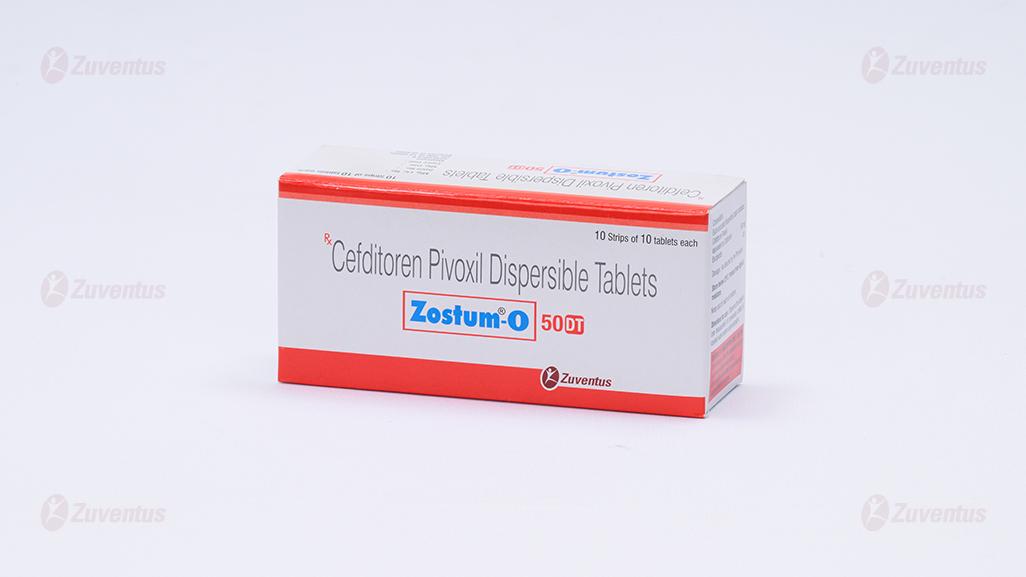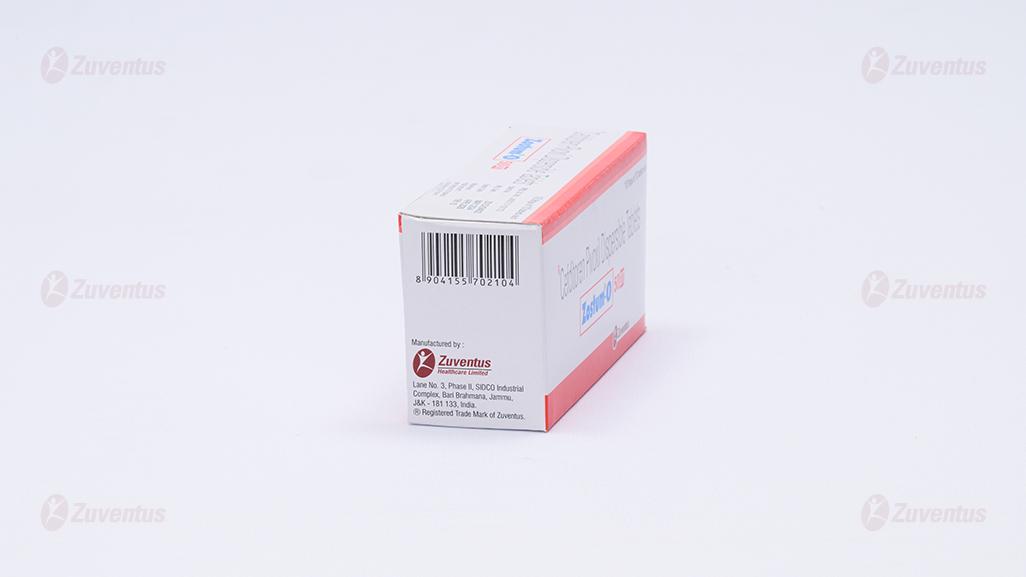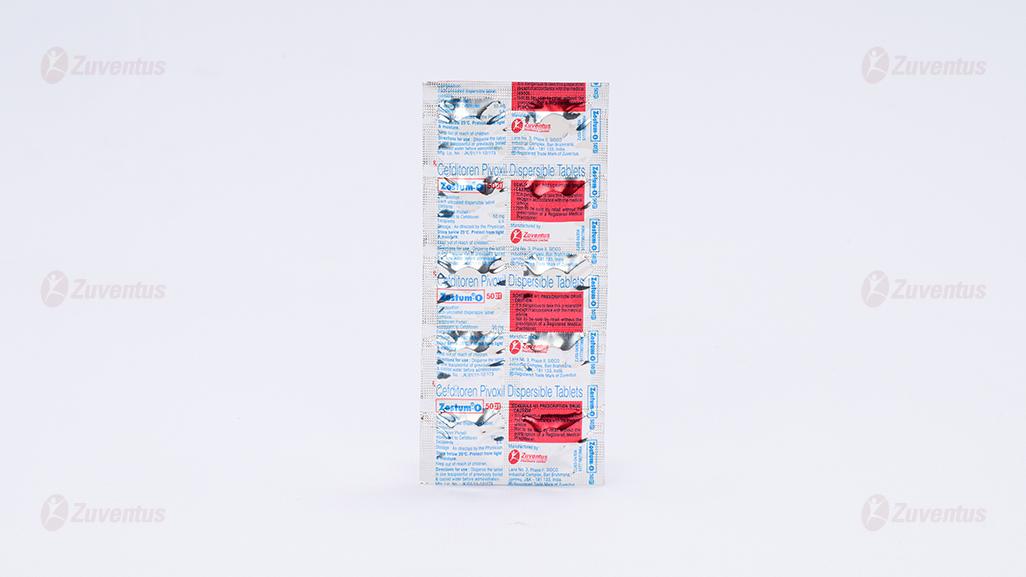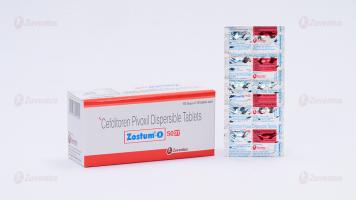Zostum-O 50 DT Tablets
Therapy Area
Anti Infective
1.0 Generic name
Cefditoren Pivoxil Dispersible Tablets
2.0 Qualitative and quantitative composition
Each uncoated dispersible tablet contains :
Cefditoren Pivoxil
equivalent to Cefditoren 50 mg
Excipients q.s.
3.0 Pharmaceutical form
Dispersible Tablet 50 mg
4.0 Clinical particulars
4.1 Therapeutic indications
Cefditoren Pivoxil is indicated for the treatment of mild to moderate infections in children (2 months to 12 years of age) which are caused by susceptible strains of the designated microorganisms in the conditions listed below:
- Acute bacterial exacerbation of chronic bronchitis.
- Community-acquired pneumonia.
- Pharyngitis / tonsillitis.
- Acute sinusitis.
- Uncomplicated skin and skin-structure infections.
4.2 Posology and method of administration
Recommended doses in children (2 months to 12 years of age)
For children with pneumonia, otitis media or sinusitis
In general, 3 mg/kg/dose, 3 times a day, after meals. The dosage may be increased up to 6 mg/kg/dose as needed, but should not exceed 200 mg, 3 times a day (600 mg/day).
For children with diseases other than above diseases
In general, 3 mg/kg/dose, 3 times a day, after meals. The dosage may be adjusted according to the disease or the patient's age and symptoms, but should not exceed 200 mg, 3 times a day (600 mg /day).
Method of administration
Disperse the tablet in one teaspoonful of previously boiled and cooled water before administration.
4.3 Contraindications
Patients with known allergy to the cephalosporin class of antibiotics or any of its components. Patients with carnitine deficiency or inborn errors of metabolism that may result in clinically significant carnitine deficiency, because use of Cefditoren Pivoxil causes renal excretion of carnitine.
4.4 Special warnings and precautions for use
- Before therapy with Cefditoren Pivoxil is instituted, careful inquiry should be made to determine whether the patient has had previous hypersensitivity reactions to Cefditoren Pivoxil, other cephalosporins, penicillins, or other drugs.
- If Cefditoren Pivoxil is to be given to penicillin-sensitive patients, caution should be exercised because cross-hypersensitivity among β-lactam antibiotics has been clearly documented and may occur in up to 10% of patients with a history of penicillin allergy.
- If an allergic reaction to Cefditoren Pivoxil occurs, the drug should be discontinued. Serious acute hypersensitivity reactions may require treatment with epinephrine and other emergency measures, including oxygen, intravenous fluids, intravenous antihistamines, corticosteroids, pressor amines, and airway management, as clinically indicated.
- Pseudomembranous colitis has been reported with nearly all antibacterial agents, including Cefditoren Pivoxil, and may range in severity from mild to life-threatening. Therefore, it is important to consider this diagnosis in patients who present with diarrhea subsequent to the administration of antibacterial agents.
- Treatment with antibacterial agents alters normal flora of the colon and may permit overgrowth of clostridia. Studies indicate that a toxin produced by Clostridium difficile is a primary cause of antibiotic-associated colitis.
- After the diagnosis of pseudomembranous colitis has been established, appropriate therapeutic measures should be initiated. Mild cases of pseudomembranous colitis usually respond to drug discontinuation alone. In moderate to severe cases, consideration should be given to management with fluids and electrolytes, protein supplementation, and treatment with an antibacterial drug clinically effective against C. difficile colitis.
- Prescribing Cefditoren Pivoxil in the absence of a proven or strongly suspected bacterial infection or a prophylactic indication is unlikely to provide benefit to the patient and increases the risk of the development of drug-resistant bacteria.
- Cefditoren Pivoxil is not recommended when prolonged antibiotic treatment is necessary. since other pivalate-containing compounds have caused clinical manifestations of carnitine deficiency when used over a period of months. No clinical effects of carnitine decrease have been associated with short-term treatment.
- Community-acquired pneumonia clinical trials demonstrated no adverse events attributable to decreases in serum carnitine concentrations. However, some sub-populations (e.g., patients with renal impairment, patients with decreased muscle mass) may be at increased risk for reductions in serum carnitine concentrations during Cefditoren Pivoxil therapy.
- As with other antibiotics, prolonged treatment may result in the possible emergence and overgrowth of resistant organisms. Careful observation of the patient is essential. If superinfection occurs during therapy, appropriate alternative therapy should be administered.
- Prothrombin time should be monitored in patients at risk and exogenous Vitamin K should be administered as indicated.
4.5 Interaction with other medicinal products and other forms of interaction
Antacids reduces the oral absorption of a single 400 mg dose of Cefditoren Pivoxil administered following a meal, by a 14% decrease in mean Cmax and an 11% decrease in mean AUC.
H2-Receptor Antagonists like Famotidine reduce the oral absorption of a single 400 mg dose of Cefditoren Pivoxil administered following a meal, by a 27% decrease in mean Cmax and a 22% decrease in mean AUC. Probenecid increases the plasma concentration of Cefditoren Pivoxil, with a 49% increase in mean Cmax, a 122% increase in mean AUC, and a 53% increase in t1/2.
4.6 Use in special populations
Pregnancy
The safety of Cefditoren Pivoxil has not been established. Cefditoren Pivoxil should not be used in pregnant women unless the potential benefits to the mother outweigh the risk to the fetus.
benefits to the mother outweigh the risk to the fetus.
Nursing mothers
Many drugs are excreted in human breast milk so caution should be exercised when Cefditoren Pivoxil is administered to nursing women.
Geriatric use
No clinically significant differences in effectiveness or safety were observed between older and younger patients. No dose adjustments are necessary in geriatric patients with normal (for their age) renal function.
4.7 Effects on ability to drive and use machines
Cefditoren Pivoxil has no or negligible influence on the ability to drive or use machines. However, Cefditoren Pivoxil may cause side effects influencing the capacity of reaction and the ability to drive and use machines.
4.8 Undesirable effects
As a result of post-marketing survey of Cefditoren Pivoxil granules, total 5,821 clinical cases were reported from 875 facilities in Japan. The number of side effects was 136 cases (2.34%), and the number of adverse reactions occurred was 146 cases. The main adverse reactions were 121 cases (2.08%) of digestive tract disorders (diarrhea, loose stools, etc.), skin and skin structure disorders (rash, urticaria) 10 cases (0.17%).
Post-marketing case study reports shows that Cephalosporin class drugs are associated with Fixed Drug Eruption (FDE).
Serious side effects (< 0.1%)
- Shock and anaphylaxis, Severe colitis (as pseudomembranous colitis), Toxic epidermal necrolysis (TEN), Stevens-Johnson syndrome, Interstitial pneumonia, Liver function disorder, Severe kidney injury, Agranulocytosis, Haemolytic anemia if any of these disorders are recognized, stop administration immediately and take appropriate measures.
- Since hypoglycemia (frequency unknown) associated with hypo-carnitineemia may be seen in cases in which antibiotics having Pivoxil groups are administered to children (especially infants), hypoglycemic symptoms such as convulsions and disturbances of consciousness are observed If so, discontinue administration and take appropriate measures.
other side effects
| Less than 0.1 to 5% | Less than 0.1% | |
| Hypersensitivity | Rash | Urticaria, erythema, Itching, Fever, Lymphadenopathy, Arthralgia |
| Blood/td> | Eosinophilia | Granulocytopenia, Thrombocytopenia |
| Liver | Rising AST (GOT), ALT (GPT) | Jaundice, Elevation of Alkaline phosphatase |
| Kidney | - | Increased BUN, Elevated blood creatinine, Proteinuria |
| G.I.T. | Diarrhea, loose stools, nausea, stomach discomfort, abdominal pain | Abdominal bloating, Nausea, Vomiting |
| Fungal infections | - | Stomatitis, Candidiasis |
| Vitamin deficiency | - | Vitamin K deficiency symptoms (Hypoprothrombinemia, Bleeding tendency etc.), Vitamin B deficiency symptoms (glossitis, Mouth ulcer, Anorexia, neuritis etc.) |
| Other | - | Headache, Dizziness, Edema, Numbness |
Reporting of suspected adverse reactions
Reporting suspected adverse reactions after authorization of the medicinal product is important. It allows continued monitoring of the benefit / risk balance of the medicinal product. Healthcare professionals are asked to report any suspected adverse reactions via email to: medico@zuventus.com
Website: https://www.zuventus.com/drug-safety-reporting
By reporting side effects, you can help provide more information on the safety of this medicine.
4.9 Overdose
Treat over-dosage symptomatically and institute supportive measures as required. In animals diarrhea and soft stool lasting for few days were observed. Gastric Lavage may be done to remove the excess drug from the stomach.
5.0 Pharmacological properties
5.1 Mechanism of action
Cefditoren Pivoxil is bactericidal in nature and its activity results from the inhibition of cell wall synthesis via affinity for penicillin-binding proteins (PBPs). It has high affinity for penicillin binding protein (PBP) of various bacteria.
5.2 Pharmacodynamic properties
Antibacterial activity Cefditoren Pivoxil is metabolized into cefditoren on absorption in the intestinal wall and shows its antibacterial activity. Cefditoren Pivoxil exerts broad spectrum antibacterial activity in vitro against gram-positive and gram-negative bacteria. Especially it showed strong antibacterial activity against gram-positive bacteria such as Staphylococcus sp., Streptococcus sp. and Streptococcus pneumoniae, and gram-negative bacteria such as Escherichia coli, Moraxella (Branhamella) catarrhalis, Klebsiella sp., Proteus sp. and Haemophilus influenzae, and against anaerobic bacteria such as Peptostreptococcus sp., Propionibacterium acnes, Bacteroides sp. and Prevotella sp. Cefditoren Pivoxil also showed antibacterial activity against β-lactamase-non producing ampicillin resistant Haemophilus influenzae (BLNAR). In vitro, Cefditoren Pivoxil was stable against β-lactamases producing strains.
5.3 Pharmacokinetic Properties
Absorption and distribution
Following oral administration, Cefditoren Pivoxil is absorbed from the gastrointestinal tract and hydrolyzed to Cefditoren by esterases. Serum concentration and pharmacokinetic parameters of Cefditoren Pivoxil were as shown in Table 1 when doses of 3 mg - 6 mg/kg were orally administered to pediatric patients with normal renal function.
Table 1: Pharmacokinetic parameters of normal pediatric patients with renal function
| Dose | Cmax (μg/mL) | T ½ (hr) | AUC 0 → ∞ (μg·hr/mL) |
| 3 mg/kg (n = 19) | 1.45 | 2.25/td> | 7.16 |
| 6 mg/kg (n = 18) | 2.85 | 1.68 | 11.90 |
After absorption Cefditoren Pivoxil is distributed to different body fluids and tissues e.g. sputum, tonsil tissue, maxillary sinus mucosa, skin tissue, tooth extraction wound etc.
Protein binding
The binding rate with human serum protein measured by ultrafiltration was 91.5% at a concentration of 25 μg/mL (in vitro).
Metabolism / excretion
Cefditoren Pivoxil undergoes metabolism upon absorption and becomes Cefditoren and pivalic acid with antimicrobial activity. Pivalic acid undergoes carnitine conjugation and is excreted in the urine as pivaloylcarnitine. Cefditoren Pivoxil is excreted largely in urine and bile without much metabolism. Urinary excretion rate (0 to 8 hours) as Cefditoren Pivoxil was about 20% and 17%, respectively, when orally administered 3 mg/kg, 6 mg/kg once or twice to pediatric patients with normal renal function.
Urinary excretion rate decreased as the extent of impairment of renal function increased, and a delay of excretion was observed.
6.0 Nonclinical properties
6.1 Animal toxicology or pharmacology
No known animal toxicology data.
7.0 Description
Zostum O 50 DT Tablet contains Cefditoren Pivoxil, a semi-synthetic cephalosporin antibiotic for oral administration. It is a prodrug which is hydrolyzed by esterases during absorption, and the drug is distributed in the circulating blood as active Cefditoren.
Chemical name: 2, 2-Dimethylpropanoyloxymethyl (6R, 7R)-7-[(Z)-2- (2-aminothiazol-4-yl)-2-(methoxyimino) acetylamino]-3-[(1Z)- 2-(4-methylthiazol-5-yl) ethenyl]-8-oxo-5-thia-1-azabicyclo[4.2.0] oct-2-ene -2-carboxylate.
Molecular formula: C25H28N6O7S3
Molecular weight: 620.72 g/mol

8.0 Pharmaceutical particulars
8.1 Incompatibilities
Not applicable
8.2 Shelf-life
Refer on the pack.
8.3 Packaging information
A strip of 10 tablets.
8.4 Storage and handing instructions
Store below 25°C. Protect from light & moisture.
Keep away from the reach of children.
9.0 Patient counselling information
- Parents or caregivers should be counselled that antibacterial drugs including Zostum O 50 DT should only be used to treat bacterial infections. They do not treat viral infections (e.g., the common cold).
- When Zostum O 50 DT is prescribed to treat a bacterial infection, patients/ parents or caregivers should be told that although it is common to feel better early in the course of therapy, the medication should be taken exactly as directed. Skipping doses or not completing the full course of therapy may (1) decrease the effectiveness of the immediate treatment and (2) increase the likelihood that bacteria will develop resistance and will not be treatable by Zostum O 50 DT or other antibacterial drugs in the future.
- Zostum O 50 DT (cefditoren pivoxil) should be taken with meals to enhance absorption.
- It is not recommended that Zostum O 50 DT be taken concomitantly with antacids or other drugs taken to reduce stomach acids.
About leaflet
- Read all of this leaflet carefully before you start taking this medicine because it contains important information for you.
- Keep this leaflet. You may need to read it again.
- If you have any more questions, please ask your doctor or your pharmacist.
- This medicine has been prescribed for you personally and you should not pass it on to anyone else. It may harm them, even if their symptoms are the same as yours.
- If any of the side effects get serious, or if you notice any side effects that are not listed in the leaflet, please tell your doctor or pharmacist.
In this leaflet:
1. What ZOSTUM-O 50 DT are and what they are used for
2. What you need to know before you take ZOSTUM-O 50 DT
3. How to take ZOSTUM-O 50 DT
4. Possible side effects
5. How to store ZOSTUM-O 50 DT
6. Contents of the pack and other information
1. What ZOSTUM-O 50 DT tablet is and what they are used for
ZOSTUM-O 50 DT tablets contains Cefditoren Pivoxil is a broad-spectrum third generation cephalosporin class antibiotic. ZOSTUM-O 50 DT is indicated for the treatment of mild to moderate infections in children (2 months to 12 years of age) which are caused by susceptible strains of the designated microorganisms in the conditions listed below:
- Inflammation and irritation of the bronchial tubes (acute bacterial exacerbation of chronic bronchitis)
- Sore throat, swollen tonsils, difficulty in swallowing and tender lymph nodes on the sides of the neck (pharyngitis /tonsillitis)
- Pneumonia (Community-acquired pneumonia).
- Nose and Nasal Sinus infection (Acute sinusitis.)
- Bacterial skin infections (uncomplicated skin and skin-structure infections)
Cefditoren is bactericidal in nature and its activity results from the inhibition of cell wall synthesis via affinity for penicillin-binding proteins (PBPs). It is stable in the presence of a variety of beta-lactamases, including penicillinases and some cephalosporinases. It is active against aerobic gram-positive pathogens like Staphylococcus aureus, Streptococcus pneumoniae and Streptococcus pyogenes and aerobic gram-negative pathogens like Haemophilus influenzae, Haemophilus parainfluenzae, Moraxella catarrhalis.
2. What you need to know before you take ZOSTUM-O 50 DT
Do not take ZOSTUM-O 50 DT if you are:
allergic to the Beta-lactam class of antibiotics or any of the components of the formulations.
Warnings and Precautions
- Before therapy with cefditoren pivoxil is instituted, careful inquiry should be made to determine whether the patient has had previous hypersensitivity reactions to cefditoren Pivoxil, other cephalosporins, penicillins, or other drugs.
- If cefditoren pivoxil is to be given to penicillin-sensitive patients, caution should be exercised because cross-hypersensitivity among ß-lactam antibiotics has been clearly documented and may occur in up to 10% of patients with a history of penicillin allergy.
- If an allergic reaction to cefditoren pivoxil occurs, the drug should be discontinued. Serious acute hypersensitivity reactions may require treatment with epinephrine and other emergency measures, including oxygen, intravenous fluids, intravenous antihistamines, corticosteroids, pressor amines, and airway management, as clinically indicated.
- Pseudomembranous colitis has been reported with nearly all antibacterial agents, including cefditoren pivoxil, and may range in severity from mild to life-threatening. Therefore, it is important to consider this diagnosis in patients who present with diarrhea subsequent to the administration of antibacterial agents.
- Treatment with antibacterial agents alters normal flora of the colon and may permit overgrowth of clostridia. Studies indicate that a toxin produced by Clostridium difficile is a primary cause of antibiotic-associated colitis.
- After the diagnosis of pseudomembranous colitis has been established, appropriate therapeutic measures should be initiated. Mild cases of pseudomembranous colitis usually respond to drug discontinuation alone. In moderate to severe cases, consideration should be given to management with fluids and electrolytes, protein supplementation, and treatment with an antibacterial drug clinically effective against C. difficile colitis.
- Prescribing cefditoren pivoxil in the absence of a proven or strongly suspected bacterial infection or a prophylactic indication is unlikely to provide benefit to the patient and increases the risk of the development of drug-resistant bacteria.
- Cefditoren pivoxil is not recommended when prolonged antibiotic treatment is necessary. since other pivalate-containing compounds have caused clinical manifestations of carnitine deficiency when used over a period of months. No clinical effects of carnitine decrease have been associated with short-term treatment.
- Community-acquired pneumonia clinical trials demonstrated no adverse events attributable to decreases in serum carnitine concentrations. However, some sub-populations (e.g., patients with renal impairment, patients with decreased muscle mass) may be at increased risk for reductions in serum carnitine concentrations during cefditoren pivoxil therapy.
- As with other antibiotics, prolonged treatment may result in the possible emergence and overgrowth of resistant organisms. Careful observation of the patient is essential. If superinfection occurs during therapy, appropriate alternative therapy should be administered.
- Prothrombin time should be monitored in patients at risk and exogenous vitamin K administered as indicated.
Interaction with other medicinal products and other forms of interaction
Antacids reduces the oral absorption of Cefditoren Pivoxil administered following a meal. H2-Receptor Antagonists like Famotidine reduce the oral absorption of Cefditoren Pivoxil administered following a meal. Probenecid increases the plasma concentration of Cefditoren Pivoxil.
Use in special populations
Pregnancy
The safety of Cefditoren Pivoxil has not been established. Cefditoren Pivoxil should not be used in pregnant women unless the potential benefits to the mother outweigh the risk to the fetus.
Nursing mothers
Many drugs are excreted in human breast milk so caution should be exercised when Cefditoren Pivoxil is administered to nursing women.
Geriatric use
No clinically significant differences in effectiveness or safety were observed between older and younger patients. No dose adjustments are necessary in geriatric patients with normal (for their age) renal function.
3. How to take ZOSTUM-O 50 DT
Follow your doctor’s instructions. Check the pharmacy label to see how many tablets to take and how often to take them. If you are still not sure, ask your pharmacist or doctor. The usual doses are described below.
Children
Recommended doses in children (2 months to 12 years of age)
- For children with pneumonia, ear infection or nasal sinus infection- In general, 3 mg/kg/dose, 3 times a day, after meals. The dosage may be increased up to 6 mg/kg/dose as needed, but should not exceed 200 mg, 3 times a day (600 mg/day).
- For children with diseases other than above diseases- In general, 3 mg/kg/dose, 3 times a day, after meals. The dosage may be adjusted according to the disease or the patient's age and symptoms, but should not exceed 200 mg, 3 times a day (600 mg /day).
Adults and children 12 year and over
This ZOSTUM-O 50 DT is not usually recommended for adults and children 12 year and over. Ask your doctor or pharmacist for advice, regarding other formulations of cefditoren.
Patients with Renal Insufficiency
No dose adjustment is necessary for patients with mild renal impairment.
Patients with Hepatic Disease
No dose adjustments are necessary for patients with mild or moderate hepatic impairment
Method of administration
Disperse the tablet in one teaspoonful of previously boiled and cooled water before administration
If you take more ZOSTUM-O 50 DT than you should
If you have taken too much cefditoren, contact your doctor, pharmacist or go to your nearest hospital immediately. In case of overdose admission into hospital may be necessary.
If you forget to take ZOSTUM-O 50 DT.
If you forget to take cefditoren, take your dose as soon as possible. If it is almost time for the next dose, just skip that dose and take the next one when it is due. If in doubt, please contact your doctor or pharmacist. If you have to skip a dose, still take all of your tablets. This means that you will finish your course a day later. Do not take a double dose to make up for a forgotten dose.
If you stop taking ZOSTUM-O 50 DT
Never stop the treatment with cefditoren on your own, but first discuss this with your doctor. If you stop taking cefditoren too soon, the infection may return. Take the tablets for the full time of treatment, even when you begin to feel better.
4. Possible side effects
In clinical trials, 4834 adult and adolescent patients have been treated with the recommended doses of cefditoren pivoxil. Most adverse events were mild and self-limiting. No deaths or permanent disabilities have been attributed to cefditoren.
The following adverse events were thought related to cefditoren tablets in multiple-dose clinical trials:
Treatment-Related Adverse Events in Trials in Adults and Adolescent Patients ≥ 12 Years of age
|
Incidence ≥ 1% |
Diarrhea Nausea Headche Abdominal Pain Vaginal Candida infection Dyspepsia Vomiting
|
Cefditoren pivoxil |
|
|
200 mg BID N = 2675 11% 4% 3% 2% 3% 1% 1% |
400 mg BID N = 2159 15% 6% 2% 2% 6% 2% 1% |
||
The overall incidence of adverse events, and in particular diarrhea, increased with the higher recommended dose of cefditoren.
Cephalosporin Class Adverse Reactions
In addition to the adverse reactions listed above which have been observed in patients treated with cefditoren pivoxil, the following adverse reactions and altered laboratory test results have been reported for cephalosporin class antibiotics
Adverse Reactions: Allergic reactions, anaphylaxis, drug fever, sever skin reactions, colitis, renal dysfunction, liver dysfunction.
Altered Laboratory Tests: Prolonged prothrombin time, liver, kidney function tests.
Several cephalosporins have been implicated in triggering seizures, particularly in patients with renal impairment when the dosage was not reduced. If seizures associated with drug therapy occur, the drug should be discontinued. Anticonvulsant therapy can be given if clinically indicated.
Tell your doctor or pharmacist if you notice any other effects not listed.
Reporting of side effects
If you get any side effects, talk to your doctor, pharmacist or nurse. This includes any possible side effects not listed in this leaflet. You can also report side effects directly: Website: www.zuventus.com and click the tab “Drug Safety Reporting” located on the top of the home page.
By reporting side effects, you can help provide more information on the safety of this medicine.
You can also report the side effect with the help of your treating physician.
5. How to store ZOSTUM-O 50 DT
Do not use the tablets after the end of the expiry month (use-by date) shown on the product packaging. Store below 25oC. Keep away from the reach of children. Store in a cool and dry place. Protect from light & moisture. Store in the original package. Medicines should not be disposed of via wastewater or household waste. Ask your pharmacist how to dispose of medicines no longer required. These measures will help to protect the environment.
6. Contents of the pack and other information
What ZOSTUM-O 50 DT contains
The active substance of ZOSTUM-O 50 DT is cefditoren.
Composition
Each uncoated dispersible tablet contains:
Cefditoren Pivoxil
equivalent to Cefditoren 50 mg
Excipients q.s.
Package information
A strip of 10 tablets.
12.0 Date of revision
06 April 2023










